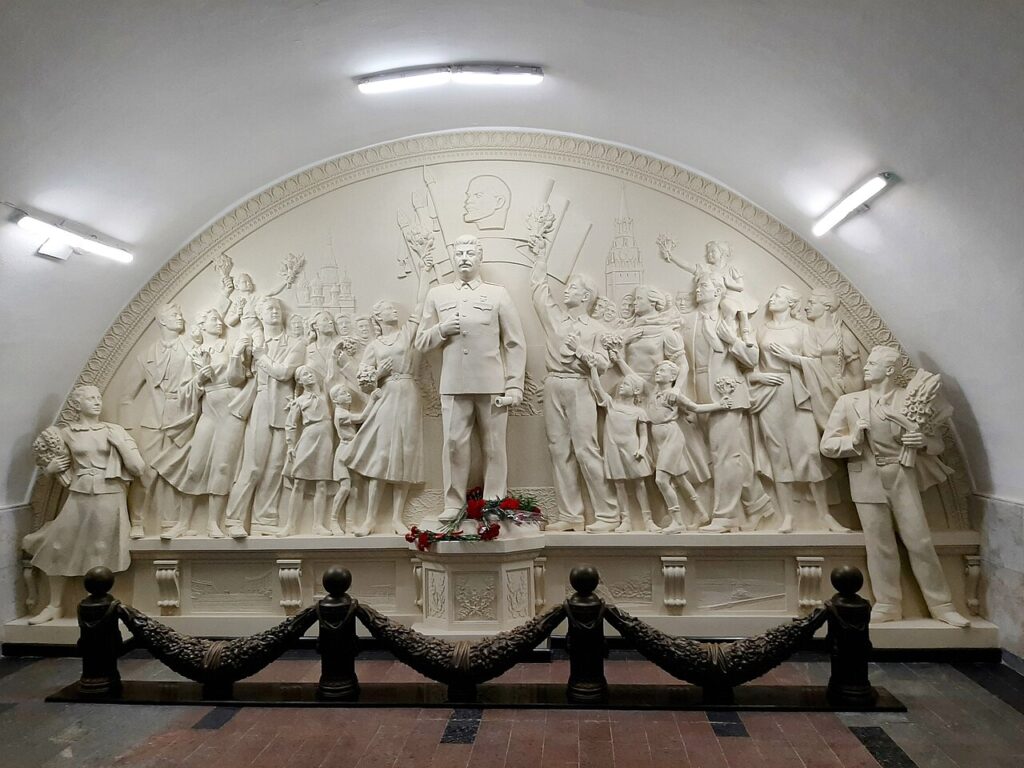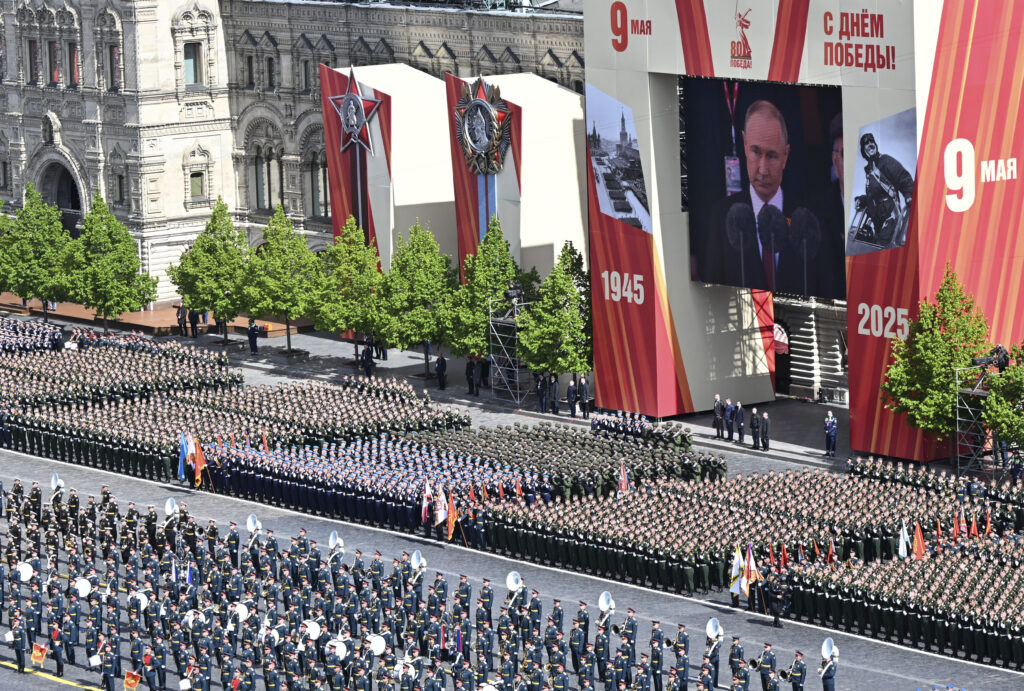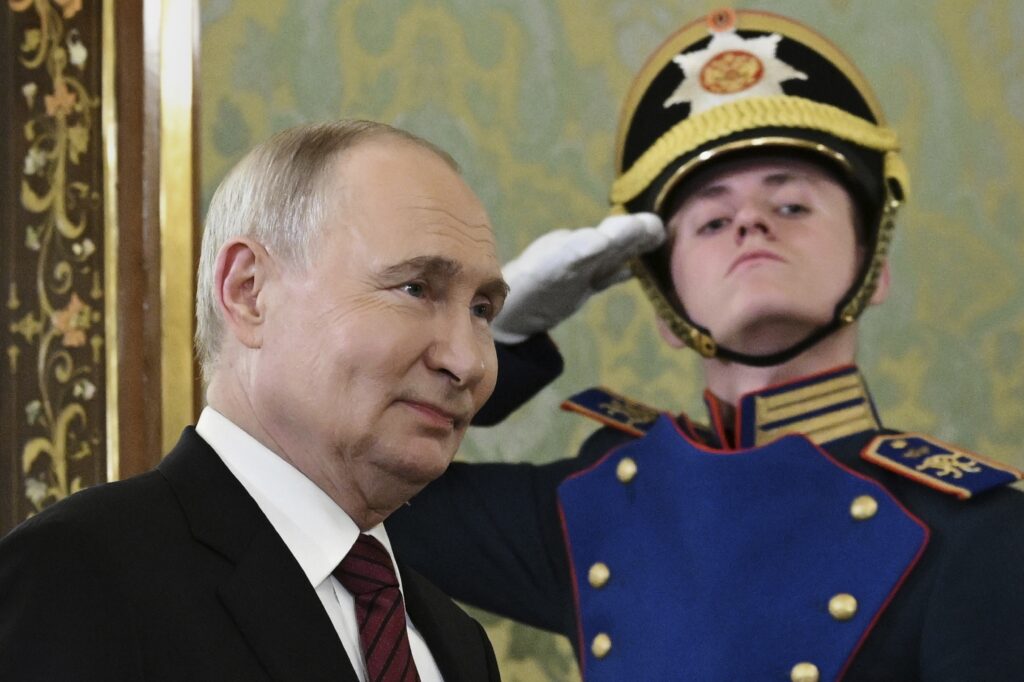Stalin, in Portraits and Sculptures, Returns to Moscow To Help Putin Wage War on Ukraine
‘For well over a decade, school textbooks and lessons have portrayed Stalin in an increasingly positive way,’ a professor notes as images of the late tyrant emerge across Russia.

As President Putin presses his war against Ukraine, the Moscow subway system has unveiled a bas-relief proclaiming: “Gratitude of the People to the Leader-Commander.” In this case, the leader is Joseph Stalin.
The Soviet dictator’s image has been taboo since his death in 1953. Under the Krushchev “thaw” of the late 1950s, busts of Stalin were removed, portraits were taken down, and murals were plastered over. During the quarter-century of Mr. Putin’s rule of Russia, busts of Stalin have made a cautious return to public view, largely in remote villages and towns.
In Moscow today, though, there is nothing tentative about the life-size bas-relief of the “great leader” surrounded by adoring Soviet citizens on Red Square. It was unveiled one week after Mr. Putin presided over a grandiose Red Square parade marking 80 years since the Soviet victory in World War II. The white plaster sculpture covers a wall in a pedestrian tunnel connecting the two busiest lines in a system that carries 7.5 million people a day.

“For well over a decade, school textbooks and lessons have portrayed Stalin in an increasingly positive way, turning him from a repressive monster into a beloved public figure who won the so-called Great Patriotic War on behalf of the Russian people,” a professor of totalitarian studies, Ian Garner, wrote last week from the safety of Warsaw. “Stalin is therefore portrayed as a vital — if not the most important — element of the cult of war that shapes much of Putinist historical memory.”
Inside Russia, politically astute critics savaged the bas-relief on the grounds of aesthetics. They say the “amateurish” workmanship of today’s replica cannot hold a candle to the socialist realist original inaugurated in 1950.
“What’s been installed in the Metro today is a shoddy 3D-printed plastic shell, crudely painted to imitate glazed porcelain,” a former director of the Pushkin Museum, Elizaveta Likhacheva, sniffed in a Telegram post. “It’s PR — a crude attempt to ride the wave of ‘patriotic hype’ tied to yet another anniversary.”
A Moscow historian, Alexander Usoltsev, made a similar critique, charging that the artist is not “familiar with human anatomy.” He said: “A person can’t stand like that. One of [Stalin’s] legs is shorter than the other.”
Down in the subway, known as the Moscow Metro, Russian reporters seem to find only passersby who approve of Stalin’s return. However, in surreptitious acts of dissent, several protest posters were left at the site. They carried past quotes by Mr. Putin condemning Stalin. One remnant of Russia’s large pro-democracy movement, Yabloko, is brave enough to speak out in public.
“The installation of a memorial image of Stalin in the public space of the capital of Russia is not just a mistake, but a cynical trampling of historical truth,” the Moscow branch of the liberal party posted online. “The Stalinist regime is responsible for millions of victims, years of terror, fear, and lawlessness. We must not allow the crimes of the past to be hushed up or justified under the guise of ‘historical memory.’”

The party is collecting signatures to ask Moscow’s city government to remove the bas-relief. One prominent signer, historian, and human rights defender, Yan Rachinsky, notes that more than 750 builders and employees of the Moscow metro fell victim to Stalin’s 1937-38 purges. More than 140 were shot, including Adolf Petrikovsky, the first head of the subway system. In the 290-mile system, there is no plaque honoring these “repressed” subway workers.
In contrast, Russia’s Communist Party called the monument’s restoration “a reinstatement of historical justice.” The party, which generally supports Mr. Putin, argued for raising more images of Stalin across Moscow. Around Russia, there are now about 120 Stalin sculptures.
A new one is at Mednoye, a killing field where the Soviets shot 6,311 Polish military prisoners of war in April 1940. Last month, on the 85th anniversary, Polish memorial plaques were destroyed at the site. The Stalin bust was untouched.
Moscow’s Stalin sculpture is at Taganskaya Station on the Circle Line. On subway maps, this line is colored brown. According to urban legend, the color and circular rail route date back to a day in 1945 when engineers asked Stalin for advice on the metro’s future expansion. He left his coffee mug on a map of the new subway system. It made a circular brown mark on the map.
At the time of the dictator’s death, 10 of the 12 stations on the Circle Line had depictions of Stalin. Today’s choice to restore the Stalin image at Taganskaya illustrates how far Russia has traveled back to dictatorship.

Ever since the Krushchev thaw, Moscow’s Taganka Theater, a few steps from the metro station, was known around the world as a showcase for Russia’s avant garde. On January 10, 1970, 18 months after failing to win the American Democratic Party’s nomination for president, Senator Eugene McCarthy attended a poetry reading at the Taganka. He then drank vodka with the director, Yuri Lyubimov.
“Theater is the only way to civilize people. Most people can’t read, even though they say they can,” McCarthy told the dissident, according to a report by Bernard Gwertzman of the Times. Then, on a wall in the director’s office, the visiting American scrawled his best wishes in a space between writing from a San Francisco beat poet, Lawrence Ferlinghetti, and from a West German novelist, Heinrich Böll.
Such liberals would not be welcome in modern Russia. Two weeks ago, a Moscow court sentenced the head of Russia’s only independent election watchdog, Grigory Melkonyants, to five years in prison for working with an “undesirable” organization. Earlier, authorities officially classified this Russian citizen as “a foreign agent” — a new use for an old Stalinist term. Increasingly, Russian schools and textbooks praise Stalin as the man who, in one generation, dragged Russia to the H-bomb from the wooden plow.
“A significant part of Russian society seems to see Stalin as a charismatic godfather of imperial nationalism,” Mr. Garner writes in the Moscow Times. Once the capital’s hometown English-language newspaper, the website relocated to Amsterdam three years ago, after Russia’s full-blown attack on Ukraine. “Surrounded by enemies, Putin — like Stalin before him — may have no choice but to wage a difficult and costly war.”

